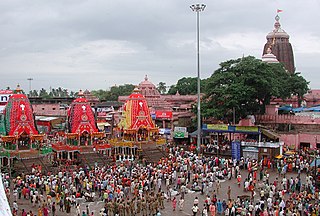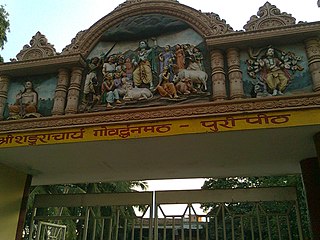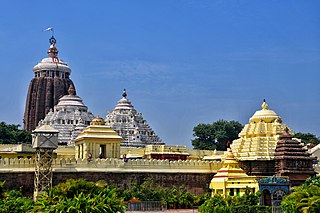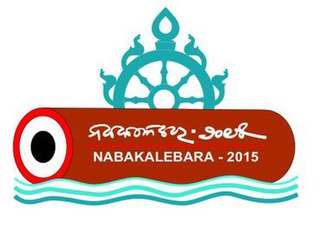
Jagannath is a deity worshipped in regional Hindu traditions in India and Bangladesh as part of a triad along with his brother Balabhadra and sister, devi Subhadra. Jagannath within Odia Hinduism is the supreme god, Purushottama, Para Brahman. To most Vaishnava Hindus, particularly the Krishnaites, Jagannath is an abstract representation of Krishna, and Mahavishnu, sometimes as the avatar of Krishna or Vishnu. To some Shaiva and Shakta Hindus, he is a symmetry-filled tantric form of Bhairava, a fierce manifestation of Shiva associated with annihilation.

Ratha Yatra is a Hindu festival associated with Lord Jagannath held at Shri Khetra Puri Dham in the state of Odisha, India. It is the oldest Ratha Yatra, whose descriptions can be found in Brahma Purana, Padma Purana, and Skanda Purana and Kapila Samhita. Rath Yatra or Jatra is the celebration of the Lord Jagannath, who is believed to be the Lord of Universe's journey towards his aunt's house.

Purvamnaya Sri Govardhana Peetham or Govardhan Math is one amongst the four cardinal peethams established by the philosopher-saint Bhagwan Adi Shankaracharya to preserve and propagate Sanatana Dharma and Advaita Vedanta, the doctrine of non-dualism. Located in Puri in Odisha, India, it is the Eastern Āmnāya Pītham amongst the four Chaturamnaya Peethams, with the others being the Sringeri Śārada Pīṭhaṃ (Karnataka) in the South, Dvārakā Śāradā Pītham (Gujarat) in the West, and Badari Jyotirmaṭha Pīṭhaṃ (Uttarakhand) in the North. It is associated with the Jagannath temple. Their Vedantic mantra or Mahavakya is Prajñānam brahma and as per the tradition initiated by Adi Shankara it holds authority over Rig Veda.

The Jagannath Temple is an important Hindu temple dedicated to Jagannath, a form of Sri Krishna in Puri in the state of Odisha on the eastern coast of India. The present temple was rebuilt from the 10th century onwards, on the site of an earlier temple, and begun by Anantavarman Chodaganga Deva, the first king of the Eastern Ganga dynasty.

Mahima Dharma is an Indian religion practiced primarily in Odisha and nearby states. The religious movement was based on the condemnation of all religious customs set by the rich and upper-class society generally.

Vaishnavism is one of the major Hindu denominations along with Shaivism, Shaktism, and Smartism. According to a 2010 estimate by Johnson and Grim, Vaishnavites are the largest Hindu sect, constituting about 641 million or 67.6% of Hindus. It is also called Vishnuism since it considers Vishnu as the sole supreme being leading all other Hindu deities, ie Mahavishnu. Its followers are called Vaishnavites or Vaishnavas, and it includes sub-sects like Krishnaism and Ramaism, which consider Krishna and Rama as the supreme beings respectively.

Krishnaism is a large group of independent Hindu traditions—sampradayas related to Vaishnavism—that center on the devotion to Krishna as Svayam Bhagavan, Ishvara, Para Brahman, the source of all reality, who is not an avatar of Vishnu. This is its difference from such Vaishnavite groupings as Sri Vaishnavism, Sadh Vaishnavism, Ramaism, Radhaism, Sitaism etc. There is also a personal Krishnaism, that is devotion to Krishna outside of any tradition and community, as in the case of the saint-poet Meera Bai. Leading scholars do not define Krishnaism as a suborder or offshoot of Vaishnavism, considering it a parallel and no less ancient current of Hinduism.

Bhima Bhoi (1850–1895) was a saint, poet and philosopher from the state of Odisha in India. Bhima Bhoi was a bhakta of Mahima Swamy. From Mahima Swamy, Bhima Bhoi would receive initiation into Mahima Dharma, an Indian religious tradition that challenged the authority of caste Hinduism on its own terms.
Anncharlott Eschmann was a scholar of religion.
Hermann Kulke is a German historian and Indologist, who was professor of South and Southeast Asian history at the Department of History, Kiel University (1988–2003). After receiving his PhD in Indology from Freiburg University in 1967, he taught for 21 years at the South Asia Institute of Heidelberg University (SAI).

Joranda Gadhi is a temple built in a location where three villages meet: Joranda, Natima and Patna. The temple is dedicated to the supreme lord. The followers of mahima dharma worship him as Sunya Brahma or the shapeless lord. No idol worship is permitted in this sect. The temple is dedicated to the supreme lord. Many people of other sects believe that the followers of this sect worship Surya, the sun god, but it is absolutely false. They just pray to the supreme lord facing to the direction of surya because it fixes the direction of concentration. One can choose one's own fix direction apart from east and west, but once fixed it cannot be changed.
Dinakrushna Das was a poet of Odisha, India, belonging to the Vaishnava tradition of bhakti movement. He is known for his Odia poem titled "Rasakallola", which is devoted to Lord Krishna. Among his many literary compositions, "Artatrana Chautisa" is a reputed one. Dinakrusna's Rasakallola and his standalone compositions including "chaupadi", "prabhati", "janana", "chautisa", "bhajana", and "malasri" are central to the repertoire of Odissi music, the traditional classical music of the state.

Chari Kshetra is a group of four holy regions in Odisha. When Vishnu killed the demon Gayasura, to commemorate the glory of his victory, he placed his Sankha (conch) in Puri, Chakra (disc) in Bhubaneswar, Gadaa (mace) in Jajpur and Padma (lotus) in Konark and they were known as Sankha Kshetra, Chakra Kshetra, Gada Kshetra and Padma Kshetra respectively.

The abode of Hindu deity Jagannath at Puri is known as the Nilachala or Niladri, [Nila (Blue) + Achala (Mountain)] meaning, The Blue Mountain.
Heinrich von Stietencron was a German Indologist. He was a Professor and the Director of the Institute of Indology and Comparative Religion at the University of Tübingen. He was a life member of the Academy of Sciences, Heidelberg and an honorary member of the Société Asiatique, Paris. He was awarded the Padma Shri by the President of India in 2004.

Pingua is a village in Dhenkanal district, Odisha, India.

The Nabakalebara 2015 is a celebration of the ancient ritual of the Nabakalebara associated with most of the Jagannath Temples when the idols of Lord Jagannath, Balabhadra, Subhadra and Sudarshan are replaced by a new set of idols; the last such festival of events was held in 1996. It is a festival the period of which is chosen according to the Hindu Calendar conforming to the astrological planetary positions. The festival during 2015 involves several schedules, and it has started from 23 March with Banajaga Yatra and will conclude with Rathayatra followed Sunabesa on 27 July, with many other rituals being held in between on specific dates. More than 5 million devotees are expected to participate in these rituals held in and around the temple complex of the Jagannath Temple, Puri, Odisha.

Satya Narayan is another name of Vishnu or Narayana, who is worshipped by Hindus, mainly in the Indian states of Andhra Pradesh, Gujarat, Madhya Pradesh, Maharashtra, Punjab, Haryana, Chandigarh, Uttar Pradesh, Chhattisgarh, West Bengal, Jharkhand, Bihar, Assam, Manipur and Tripura. His avatar is Krishna. Satya Narayan is part of a triad on the ratnavedi.

Vira Pratapa Purushottama Deva was the second Gajapati emperor of Odisha who ruled from 1467 to 1497 C.E. He was the second ruler from the Suryavamsa Gajapati Empire. His father Gajapati Kapilendra Deva Routaraya chose him as his heir to rule Odishan Empire at the banks of river Krishna where he breathed his last. This decision infuriated the elder brother Hamvira Deva who was a battle hardened and successful warrior fulfilling the task of conquering the southern territories and expeditions against the kingdom of Vijayanagara as wished by his father.
Bisara Mohanty was a devotee and historical figure of Jagannath culture, who rescued Daru Brahma of Lord Jagannath from the river Ganga. He was a contemporary of King Ramachandra Deva I.














